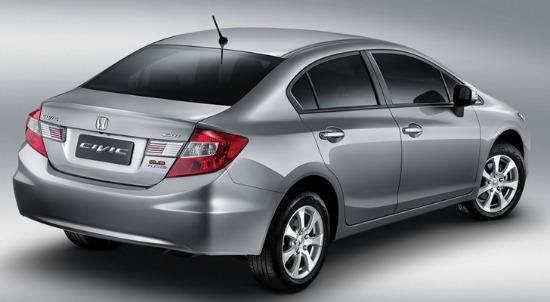Honda is moving quickly to improve its popular Civic. Its update in 2012 eliminated the cost-cutting complaints about this long-popular model.
The 2012 Honda Civic was far from being marginal. Like other Civics, it was safe, reliable and fuel-efficient. But it had a rather bland design, and there were complaints about its handling, steering, ride and road noise.
The front-drive compact Civic is a Honda bread-and-butter car, so the automaker quickly upgraded it with a more upscale appearance, using such items a Honda Accord-style grille and new wheels, hood, trunk lid and taillights. The interior also was improved with better materials and upholstery. Among few changes for 2014 are small horsepower increases.

There still are a few signs of cost-cutting. For instance, the sun visor vanity mirrors can’t be lit, and the trunk lid has no interior pull-down handle to help close it without getting hands dirty on outside sheet metal.
The updated model has better steering and handling, along with more sound-deadening material and added standard equipment, including a back-up camera.
However, I found while testing a 2014 Civic sedan that the digital speedometer could be distracting to some drivers. The Civic should at least have an auxiliary standard “speedo” next to the large conventional tachometer, which is rather superfluous except in the standard five-speed stick shift and racy stick-shift-only (six-speed manual) Si model. Still, all backlit gauges are easy to read in bright sunlight.

There seemingly is a Civic sedan and coupe for everyone in a wide variety of price ranges. Sedan prices start with the $18,390 LX with a five-speed manual transmission ($19,940 with a CVT automatic transmission) and then cover the waterfront with the EX, EX-L, HF, Si, Hybrid gas/electric and end at $24,635 for the Hybrid without extras (not including the low-volume $26,640 Natural Gas model).
I tested the $22,740 EX-L, which has a price jump to $24,240 with items such as a navigation system.
The coupe comes in LX and Si forms, with the LX costing $18,190 ($18,990 with CVT), and the Si is priced at $22,790 with the six-speed manual—or at $24,490 with summer tires.
Most Civics have a 1.8-liter four-cylinder engine with 143 horsepower and 129 pound/feet of torque. This engine provides good city and highway performance and can use regular-grade fuel. Economy is a plus. For instance, the base LX sedan delivers an estimated 28 miles per gallon in the city and 36 on highways with its manual gearbox or 28 and 39 with the CVT.
The hot rod Si coupe and sedan have a 2.4-liter four-cylinder with 205 horsepower and 174 pound-feet of torque. The Si is naturally quicker than the lower-horsepower
Civics, but calls for premium gasoline. It delivers 22 miles per gallon in the city and 31 on highways.
My test had an “Econ” mode that is switched on or off with a dashboard button. When activated, it’s said to help improve fuel economy by adjusting the performance of the engine, transmission, heating and cooling system and cruise control.
The Hybrid provides an estimated 44 miles per gallon in the city and 47 on highways.
The Civic is well-equipped, but only higher-priced versions get upscale equipment. For instance, my EX-L test sedan had items including a moonroof, automatic climate control, heated front seats, rearview camera, pushbutton start, cruise control, power windows and locks and a tilt/telescopic wheel.
The revised Civic—most especially the Si—is fun to drive. It steers nicely and moves easily through curves with its all-independent suspension, stability assist and traction control systems and front/rear stabilizer bars.
The suspension is on the firm side, but shrugs off road imperfections and never jars occupants. The brake pedal has a nice action and electronic brake force distribution for surer emergency stops.
Safety items include side curtain air bags with rollover sensors.
Large door handles help make it easy to enter the quiet interior, although rear door openings are rather narrow. Front seats are supportive in curves, and the interior is roomy, both front and back, with a decent number of storage areas. Even the center of the rear seat is soft enough to comfortably accommodate a third passenger.
A fold-down armrest with cupholders can be pulled down to occupy the middle of the backseat. However, the front armrest partly blocks access to one of the front console cupholders.
The sedan’s large trunk has a low, wide opening. The lid has interior padding but gooseneck hinges instead of hydraulic struts. Rear seatbacks flip forward via trunk-mounted release levers and sit flat to increase the cargo area, although the pass-through area from the trunk is only moderately large.
The hood also has interior padding for sound control but is held open with an awkward prop rod, instead of hydraulic struts. The under-hood area is surgically neat, with easily reached fluid-filler areas.
A Civic buyer may have to sort through the variety of trim levels and prices to get the model he likes and can afford. But all Civics are solid, with good resale value.
Pros: Slick styling. Roomy. Fuel-stingy. Good road manners. Model variety.
Cons: Offbeat instrument panel. Narrow rear door openings.
Bottom Line: Civic retains its high-scoring personality.
Dan Jedlicka has been an automotive journalist for more than 40 years. To read more of his new and vintage care reviews, visit: www.danjedlicka.com.
Article Last Updated: April 22, 2014.